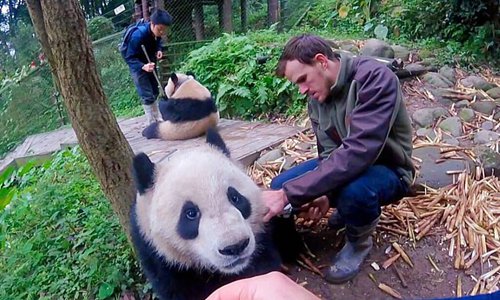
Global Cause Foundation scientists weigh and measure two panda cubs in Panda Valley in Sichuan Province before their release into the wild. (Photo/Courtesy of Global Cause Foundation)
○ A Sino-U.S. cooperative project to release pandas into the wild has come under scrutiny after a captive-born cub was killed by other animals
○ Some panda fans have questioned why the project did not follow reintroduction methods used previously in China which minimize human interactions with the bears prior to release
○ Expert say conserving habitats, rather than reintroduction, is of paramount importance to protecting pandas from extinction
Tyler Robert, a panda enthusiast living near San Francisco, said he is sad and angry about the death of Hesheng, one of the first pair of panda cubs to participate in a joint Sino-U.S. project to introduce captive-born bears into the wild.
He and many other panda fans blame the project's methods for the bear's death.
The 3-year-old male cub was killed by "unknown animals" in September 2016, two months after he was released into the wild, the Chengdu Research Base of Giant Panda Breeding (CRBGPB) in Southwest China's Sichuan Province said in a March 29 statement issued via its Sina Weibo account.
Robert believes the base would not have revealed the death if he and other panda fans had not protested online - they repeatedly demanded the research base update them about Hesheng and the other cub, Qianqian, after they were released in July last year.
"We all love and care about pandas and we deserve to be informed if anything happens to the pandas. Keeping us in the dark makes their deaths look suspicious," Robert told the Global Times in an e-mail.
Robert is not alone in being skeptical about the project's methods, claiming the project will be "meaningless" if the methods are "wrong."
Doubts
In 2008, the CRBGPB, known for having the world's largest artificially-bred population of giant pandas, started to build the Dujiangyan Field Research Center for Giant Pandas, also known as Panda Valley, for its re-wilding program.
In 2014, Panda Valley was opened and the base officially launched its reintroduction program, inviting scientists from the Virginia-based Global Cause Foundation (GCF) to get involved.
According to GCF's website, the team's "unique approach" builds on the "innovative methods" of Benjamin Kilham, a GCF scientist and bear behavior expert who has pioneered the reintroduction of black bears to the wild.
Using these methods on pandas has met with controversy, with some questioning GCF scientists' qualifications when it comes to pandas. A panda fanatic from Hong Kong investigated the GCF scientists involved in the project and claimed none of them have prior panda-specific experience.
In addition, she and other panda fans like Robert were "shocked" to see that there was so much human interaction with the pandas while they were being trained for reintroduction.
What puzzled them most were pictures released by GCF of workers teaching cubs to find water, climb trees and eat bamboo. "Are they training cubs to be obedient pets or to survive in the wild?" one netizen wondered.
In a picture the foundation posted on December 15, 2016, a woman wearing blue overalls is seen holding a stalk of bamboo close to a bear's mouth. The image was captioned, "Dr. Callan helps Nida learn the proper way to eat leaves."
Rama Callan is a GCF researcher at Panda Valley; 16-month-old captive-bred Nida and Xiaochuan are the pair of pandas which are being trained for the project's second round of releases.
"As far as I know, pandas that are to be released into the wild are usually kept away from all kinds of direct human interaction and the keepers wear 'panda costumes' to go near them. Looking at those photos I knew that these pandas are not going to survive in the wild," Robert said.
Ritsuku, a Japanese panda fan, also joined the chorus of concern over the Chengdu base and the GCF. "We are very sad about Hesheng's death. We think that he is the victim of their research and this is a tragedy. More explanation is necessary," she told the Global Times.


















































